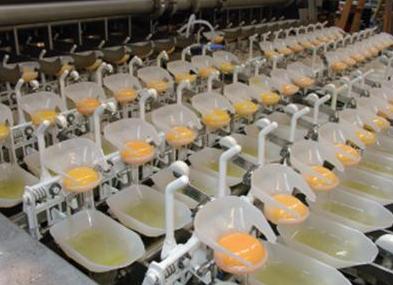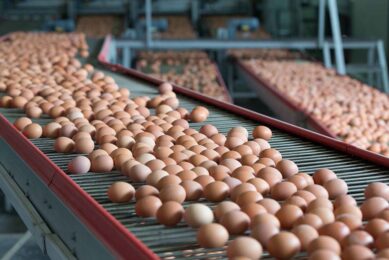Taking eggs further – Part 2: Maximum yield through proper processing

Raw egg material accounts for 80% of all costs in a processing plant – every last drop is money. Gentle cracking and correct opening along with gentle handling of the yolk and white are imperative for reaching the highest yield. By achieving just 0.5% more yield can mean huge profit gains.
By Christoffer Ernst,Sanovo Staalkat Group, Sjanghai, China
Breaking by centrifuge is banned in most industrialised nations due to the contamination and risk factors that diminish the safety and quality of the end product. According to international standards, eggs must be broken by approved egg breaking and separating systems. Each egg broken must be individually inspected in individual cups, and the possibility of removing a contaminated egg from production is necessary. Centrifuges offer highest yield, however, quality and safety are severely diminished. The centrifuge tears apart the proteins of the egg white, and homogenises the yolk and white. Important functions of the white (such as binding) are severely minimised by centrifuge. With diminished functions, more product material is needed to perform the same task, adding to end costs. Bacteria is highly concentrated on the shells, and by processing with a centrifuge, the liquid egg comes into direct contact with the outer shell contaminating the liquid product, highly increasing the bacteria count and thus reducing the end shelf-life and quality. Also, when using a centrifuge, it is not possible to separate yolk and whites.
Therefore, a safe and clean opening of the egg shell by special knives and holders is crucial to allow a safe and uncontaminated draining of the liquid egg. The liquid should be separated into two products, being egg white and yolk. Later, a ratio of the whites and yolk can be mixed to produce a desired amount of whole egg. Cups made of HDPE (High Density Polyethylene) offer hygienic and gentle collection and separation of the liquids – the material is resilient like stainless steel, but offers better hygiene and easier cleaning.
Furthermore, using a breaker with HDPE cups reduces the noise in the breaking room, while also reducing the energy required to run the system, thereby helping to reduce the carbon footprint of the factory. It is important that the breaking process is set up in the most hygienic and efficient way, as this is the only place in the plant where the egg is exposed. Having a breaking machine that is fully enclosed not only offers optimal hygiene, but also enhanced operator safety.
Washing – yes or no?
USDA regulations demand that all eggs for human consumption are washed. This rule is being discussed in Europe and in China. Washing is a government regulation in Taiwan. Washing requirements also differ from country to country, from simple cleaning to washing with high pressure nozzles and brushes. However, with washing comes a demand for an integrated cold chain, as the eggs must then be kept at or below 4°C to avoid rapid bacteria growth. Washing removes the natural protective coating that an egg is laid with. One way to help this is to include a system for oiling, with edible vegetable oil after washing, however, shelf-life of the eggs is reduced.
Gentle handling
Eggs, accounting for 80% of the costs, are the most important factor in any processing facility, being grading or further processing. Gentle handling from the laying hen to the end product is crucial. Correct farm management, handling and control of the birds, transport of eggs from the farm to the grading centre and the egg processing facility are key. In the egg processing facility gentle loading and washing, correct breaking methods (by gentle cracking), opening and handling of the egg through delivery of the liquid to individual cups further increase yield. Equipment for handling the liquid after breaking further needs to be manufactured with the final quality in mind. Piping is imperative, with clean connecting points and welding, to reduce the build-up of egg in the pipes, a feasting ground for bacteria build up. Filtering and cooling must be carefully considered during machine design for handling of liquid egg, as well as correct pasteurising on a dedicated egg products pasteuriser, with ability to heat treat and handle the high viscosity of eggs and thoroughly handle the product without destroying the functions. Further important equipment includes storage and holding of the liquid in tanks that retain the freshness of the product, to filling systems and box spray driers specifically built for the drying of liquid eggs. Finally, specific cleaning systems (CIP) for the complete cleaning of the entire plant and all equipment are imperative for generating the highest yield and best quality end product.
Pasteurising and shelf-life
There is always a lot of talk about shelf-life and producing extra long shelf-life egg products. The technology is out there, and shelf-life of over two months is not unheard of. However, with today’s available technology, the shelf-life can only be extended at a cost, and the cost is reduced functionality. Some ways of producing extended shelf-life include ultra high temperature pasteurisation, the addition of preservatives (i.e. salt, sugar or citric acid) and aseptic filling and packing. But in all cases, extended shelf-life requires ultra sanitary processing practices together with ultra fresh shell eggs. We see products in the US with over two months shelf-life, but these products are only used for premixed omelette or scrambled egg products, where the special functions of the egg do not play a role. On an industrial level, and with egg products as an ingredient, it is crucial for the end user to have a product as close to fresh shell eggs as possible. This means retaining all the functional properties in the egg.
Spray drying
The idea of drying egg products originates in Asia, specifically China. At the turn of the last century, Chinese companies were drying egg products in trays left outside where the heat from the sun would evaporate the moisture in the eggs, producing a dry product. These products where then exported to the US by ship. Today, the principle is the same, using heat to evaporate moisture, however, the technology is much different. Now, all liquids containing dry solids can be spray-dried into powder. Liquid egg is pumped at high pressure through nozzles into a drying chamber. As the liquid mixes with the heated air, the moisture is evaporated leaving behind a dry product.
The reasons for drying eggs remains more or less the same: it extends shelf-life from days to years; it reduces storage and transportation costs, and; it allows producers to buy eggs at a lower price, produce powder, and then sell the powder later when the egg prices increase, offering enhanced margins. Powder can easily be reconstituted back to a liquid product by mixing it with water.
There is also a growing market for hard-boiled peeled eggs. This is already mainstream business in the US and in parts of Europe, with end users typically being catering, schools and hospitals. It is also a growing industry across Asia, particularly in Taiwan, Korea and China. Just like egg products, producing and supplying hard-boiled peeled eggs on a sanitary system provides users with safety, quality and uniformity. The products are primarily sold in bulk, but can also be found in retail packs and vacuum packs.
Quality control
Every processing plant needs to adhere to strict quality control measures. This is a demand from local customers, but also needs to be adhered to in order to export. Each country has different requirements, and detailed documentation needs to follow every batch of product. Today, processors first check the fresh shell eggs coming in on analysing equipment to check the freshness of the egg (Haugh Unit), the strength of the shells, and the colour of the yolk. Detailed micro and macro biological tests are also needed, including total plate count for Salmonella and E. Coli, for example. Detailed reports are made based on the findings, and customers will cross-check these reports.
So, why make pasteurised products? It is what the food and catering industry needs. Even in countries in Asia, where there is no egg processing, egg products are being imported at high prices, in either frozen or powder form. Local production will allow the local market access to competitive prices and a quick supply. The food industry has a responsibility to produce safe products, and for this they need safe, convenient ingredients. Furthermore, they require uniformity in order to maintain their recipes and production processes, all the time while demanding less waste, better hygiene and total product use.
More then meets the eye
So, when you think of it, there certainly is more to the egg than meets the eye! The egg goes through many stages before making it to the consumer, whether in the shell or as a product. There is a large and growing industry behind eggs, taking them further. Here is an industry that is continuously developing, integrating, modernising and striving to produce better products at better margins. With the world becoming smaller, more eggs are crossing borders, resulting in uniform demands and quality expectations. This, in turn, requires specialised equipment and processes, both readily available. Asia, as a whole, is in a unique position to learn from the curve that western countries have been going through since the early 1940s, when egg industrialisation really took off. Methods and models from the west can be adapted to local requirements, without the need to re-invent the wheel.
Join 31,000+ subscribers
Subscribe to our newsletter to stay updated about all the need-to-know content in the poultry sector, three times a week. Beheer
Beheer








 WP Admin
WP Admin  Bewerk bericht
Bewerk bericht